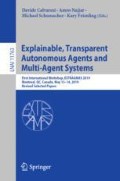Abstract
We are entering a new age of AI applications where machine learning is the core technology but machine learning models are generally non-intuitive, opaque and usually complicated for people to understand. The current AI applications inability to explain is decisions and actions to end users have limited its effectiveness. The explainable AI will enable the users to understand, accordingly trust and effectively manage the decisions made by machine learning models. The heat recycler’s fault detection in Air Handling Unit (AHU) has been explained with explainable artificial intelligence since the fault detection is particularly burdensome because the reason for its failure is mostly unknown and unique. The key requirement of such systems is the early diagnosis of such faults for its economic and functional efficiency. The machine learning models, Support Vector Machine and Neural Networks have been used for the diagnosis of the fault and explainable artificial intelligence has been used to explain the models’ behaviour.
Access this chapter
Tax calculation will be finalised at checkout
Purchases are for personal use only
References
Support Vector Machine. https://medium.com/machine-learning-101/chapter-2-svm-support-vector-machine-theory-f0812effc72. Accessed 26 Feb 2019
ELI5 (2019). https://github.com/TeamHG-Memex/eli5. Accessed 04 June 2019
LIME (2019). https://towardsdatascience.com/. Accessed 04 June 2019
Shap (2019). https://github.com/slundberg/shap. Accessed 04 June 2019
Skater (2019). https://github.com/oracle/Skater. Accessed 04 June 2019
Adadi, A., Berrada, M.: Peeking inside the black-box: a survey on explainable artificial intelligence (XAI). IEEE Access 6, 52138–52160 (2018)
Anjomshoae, S., Främling, K., Najjar, A.: Explanations of black-box model predictions by contextual importance and utility
Anjomshoae, S., Najjar, A., Calvaresi, D., Främling, K.: Explainable agents and robots: results from a systematic literature review. In: Proceedings of the 18th International Conference on Autonomous Agents and Multiagent Systems, pp. 1078–1088. International Foundation for Autonomous Agents and Multiagent Systems (2019)
Beghi, A., Brignoli, R., Cecchinato, L., Menegazzo, G., Rampazzo, M.: A data-driven approach for fault diagnosis in HVAC chiller systems. In: 2015 IEEE Conference on Control Applications (CCA), pp. 966–971. IEEE (2015)
Du, Z., Jin, X., Wu, L.: Fault detection and diagnosis based on improved PCA with JAA method in VAV systems. Build. Environ. 42(9), 3221–3232 (2007)
Du, Z., Jin, X., Yang, Y.: Wavelet neural network-based fault diagnosis in air-handling units. HVAC&R Res. 14(6), 959–973 (2008)
Främling, K.: Explaining results of neural networks by contextual importance and utility. In: Proceedings of the AISB 1996 Conference. Citeseer (1996)
Främling, K.: Modélisation et apprentissage des préférences par réseaux de neurones pour l’aide à la décision multicritère. Ph.D. thesis, INSA de Lyon (1996)
Främling, K., Graillot, D.: Extracting explanations from neural networks. In: Proceedings of the ICANN, vol. 95, pp. 163–168. Citeseer (1995)
Guidotti, R., Monreale, A., Ruggieri, S., Turini, F., Giannotti, F., Pedreschi, D.: A survey of methods for explaining black box models. ACM Comput. Surv. (CSUR) 51(5), 93 (2018)
Gunning, D.: Explainable artificial intelligence. Technical report released by DARPA (2017)
Holzinger, A., Biemann, C., Pattichis, C.S., Kell, D.B.: What do we need to build explainable AI systems for the medical domain? arXiv preprint arXiv:1712.09923 (2017)
Lee, W.Y., House, J.M., Park, C., Kelly, G.E.: Fault diagnosis of an air-handling unit using artificial neural networks. Trans.-Am. Soc. Heat. Refrig. Air Cond. Eng. 102, 540–549 (1996)
Madhikermi, M., Yousefnezhad, N., Främling, K.: Heat recovery unit failure detection in air handling unit. In: Moon, I., Lee, G.M., Park, J., Kiritsis, D., von Cieminski, G. (eds.) APMS 2018. IAICT, vol. 536, pp. 343–350. Springer, Cham (2018). https://doi.org/10.1007/978-3-319-99707-0_43
Mills, E., et al.: The cost-effectiveness of commissioning new and existing commercial buildings: lessons from 224 buildings. In: Proceedings of the National Conference on Building Commissioning (2005)
Pérez-Lombard, L., Ortiz, J., Pout, C.: A review on buildings energy consumption information. Energy Build. 40(3), 394–398 (2008)
Ribeiro, M.T., Singh, S., Guestrin, C.: Why should i trust you?: explaining the predictions of any classifier. In: Proceedings of the 22nd ACM SIGKDD International Conference on Knowledge Discovery and Data Mining, pp. 1135–1144. ACM (2016)
Roulet, C.A., Heidt, F., Foradini, F., Pibiri, M.C.: Real heat recovery with air handling units. Energy Build. 33(5), 495–502 (2001)
Sheh, R., Monteath, I.: Introspectively assessing failures through explainable artificial intelligence. In: IROS Workshop on Introspective Methods for Reliable Autonomy (2017)
Van Lent, M., Fisher, W., Mancuso, M.: An explainable artificial intelligence system for small-unit tactical behavior. In: Proceedings of the National Conference on Artificial Intelligence, Menlo Park, CA, pp. 900–907. AAAI Press/MIT Press, Cambridge/London 1999 (2004)
Wang, S., Xiao, F.: Detection and diagnosis of ahu sensor faults using principal component analysis method. Energy Convers. Manag. 45(17), 2667–2686 (2004)
Wang, X.F., Huang, D.S.: A novel density-based clustering framework by using level set method. IEEE Trans. Knowl. Data Eng. 21(11), 1515–1531 (2009)
Xiao, F., Wang, S.: Progress and methodologies of lifecycle commissioning of HVAC systems to enhance building sustainability. Renew. Sustain. Energy Rev. 13(5), 1144–1149 (2009)
Yan, K., Zhong, C., Ji, Z., Huang, J.: Semi-supervised learning for early detection and diagnosis of various air handling unit faults. Energy Build. 181, 75–83 (2018)
Yan, R., Ma, Z., Kokogiannakis, G., Zhao, Y.: A sensor fault detection strategy for air handling units using cluster analysis. Autom. Constr. 70, 77–88 (2016)
ten Zeldam, S., de Jong, A., Loendersloot, R., Tinga, T.: Automated failure diagnosis in aviation maintenance using explainable artificial intelligence (XAI). In: Proceedings of the European Conference of the PHM Society, vol. 4 (2018)
Zhu, Y., Jin, X., Du, Z.: Fault diagnosis for sensors in air handling unit based on neural network pre-processed by wavelet and fractal. Energy Build. 44, 7–16 (2012)
Author information
Authors and Affiliations
Corresponding author
Editor information
Editors and Affiliations
Rights and permissions
Copyright information
© 2019 Springer Nature Switzerland AG
About this paper
Cite this paper
Madhikermi, M., Malhi, A.K., Främling, K. (2019). Explainable Artificial Intelligence Based Heat Recycler Fault Detection in Air Handling Unit. In: Calvaresi, D., Najjar, A., Schumacher, M., Främling, K. (eds) Explainable, Transparent Autonomous Agents and Multi-Agent Systems. EXTRAAMAS 2019. Lecture Notes in Computer Science(), vol 11763. Springer, Cham. https://doi.org/10.1007/978-3-030-30391-4_7
Download citation
DOI: https://doi.org/10.1007/978-3-030-30391-4_7
Published:
Publisher Name: Springer, Cham
Print ISBN: 978-3-030-30390-7
Online ISBN: 978-3-030-30391-4
eBook Packages: Computer ScienceComputer Science (R0)

